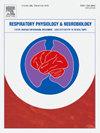Effects of inspiratory muscle metaboreflex on cerebral circulation at rest and during light-intensity exercise in healthy males
IF 1.6
4区 医学
Q3 PHYSIOLOGY
引用次数: 0
Abstract
Purpose
This study aimed to clarify the effects of inspiratory muscle metaboreflex on cerebral circulation at rest and during exercise.
Methods
Twelve young males randomly completed two trials (rest and exercise [leg cycling at 40 % peak oxygen uptake] trials) on separate days. In each trial, the internal carotid artery (ICA), an index of cerebral circulation, was measured using Doppler ultrasound 2 min after inspiratory loading breathing (IL condition) or non-loading breathing (control condition). During ICA assessments, participants engaged in 3 min of spontaneous breathing (SB), followed by 3 min of isocapnic hyperventilation (IHV).
Results
ICA conductance was lower in the IL condition than in the control condition in both rest and exercise trials. Inspiratory muscle metaboreflex did not reduce ICA blood flow during SB but decreased it during IHV in both trials.
Conclusion
Our findings suggest that inspiratory muscle metaboreflex could decrease cerebrovascular conductance from rest to light-intensity exercise and attenuates cerebral blood flow with increased respiratory muscle work.
健康男性休息和轻强度运动时吸气肌代谢反射对脑循环的影响
目的探讨静息和运动时吸气肌代谢反射对脑循环的影响。方法12名年轻男性在不同的日期随机完成两项试验(休息和运动[在40% %峰值摄氧量下腿部循环]试验)。在每个试验中,在吸气负荷呼吸(IL组)或非负荷呼吸(对照组)后2 min,采用多普勒超声测量颈内动脉(ICA),即脑循环指标。在ICA评估期间,参与者进行了3 min的自发呼吸(SB),随后进行了3 min的等负荷过度通气(IHV)。结果静、运动两种情况下,IL状态下的ica电导均低于对照组。在两项试验中,吸入肌代谢反射并没有减少SB期间的ICA血流量,但减少了IHV期间的ICA血流量。结论吸气肌代谢反射可以降低从休息到低强度运动的脑血管传导,并随着呼吸肌工作的增加而减弱脑血流量。
本文章由计算机程序翻译,如有差异,请以英文原文为准。
求助全文
约1分钟内获得全文
求助全文
来源期刊
CiteScore
4.80
自引率
8.70%
发文量
104
审稿时长
54 days
期刊介绍:
Respiratory Physiology & Neurobiology (RESPNB) publishes original articles and invited reviews concerning physiology and pathophysiology of respiration in its broadest sense.
Although a special focus is on topics in neurobiology, high quality papers in respiratory molecular and cellular biology are also welcome, as are high-quality papers in traditional areas, such as:
-Mechanics of breathing-
Gas exchange and acid-base balance-
Respiration at rest and exercise-
Respiration in unusual conditions, like high or low pressure or changes of temperature, low ambient oxygen-
Embryonic and adult respiration-
Comparative respiratory physiology.
Papers on clinical aspects, original methods, as well as theoretical papers are also considered as long as they foster the understanding of respiratory physiology and pathophysiology.

 求助内容:
求助内容: 应助结果提醒方式:
应助结果提醒方式:


